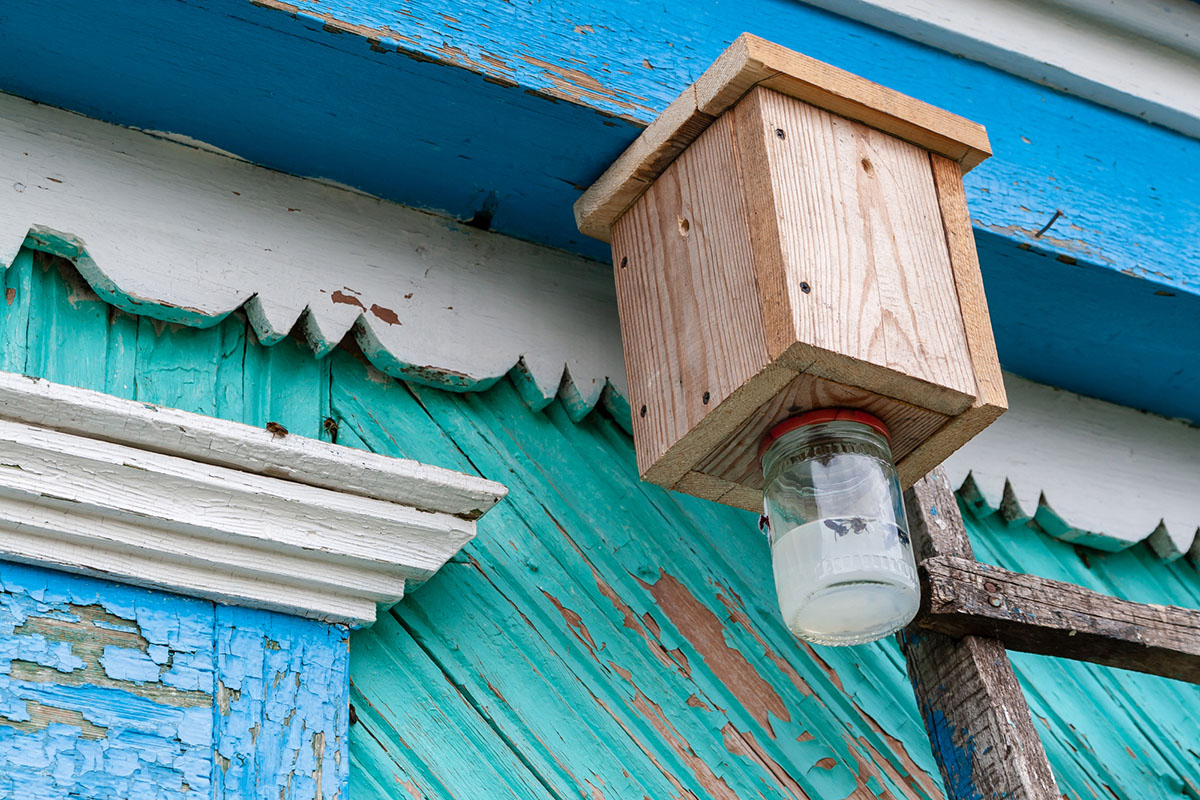We may earn revenue from the products available on this page and participate in affiliate programs. Learn More ›
Bees are wonderful insects that help create healthy, abundant gardens. What’s not so wonderful is when carpenter bees decide to take up residence in your deck, house, or fence. Carpenter bees are known for burrowing into soft, weathered woods like pine or cedar. Removing them as soon as their telltale half-inch holes are spotted is important to prevent a major infestation that can destroy the integrity of your wood. You can always choose to get some professional assistance removing them if bees make you nervous; otherwise, keep reading to learn how to make a carpenter bee trap to remove them yourself.
Time required: 30 minutesDifficulty: Beginner
Estimated cost: $5 to $15
Tools & Materials
Bobvila.com may earn a commission from purchases made through these links.
- 4×4 piece of untreated pine or cedar
- Nails
- 6-inch-wide plank of wood
- Mason jar with lid
- Small chain, wire, or cable
- Honey or sugar water (optional)
Before You Begin…
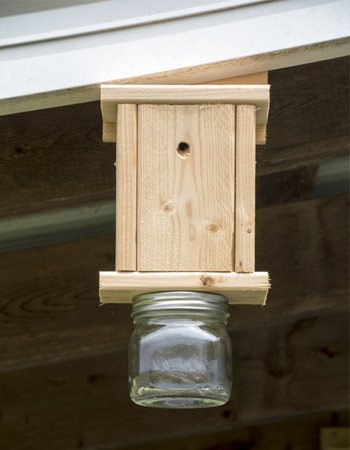
“You may consider these insects intimidating because of their huge size and loud buzz, but they’re actually very gentle and important pollinators in our environment,” according to Rachael Freeman Long from the University of California Division of Agriculture and Natural Resources.
Building a carpenter bee trap can be a fun DIY project if you already own the equipment and are familiar with using power tools. As with any project, there is a risk of accidents, so safety precautions should always be taken to avoid injury.
Tips for How to Make a Carpenter Bee Trap
- Purchase or collect the items on the materials list ahead of time so the project flows efficiently.
- Build the trap away from the area where the carpenter bees are to avoid agitating them.
- Consider adding a drop of honey or some sugar water to the mason jar to make the trap more alluring.
Safety Considerations
- Always use protective gear like safety glasses and gloves when using power tools or saws.
- Work on a stable surface to avoid accidents and prevent the project from tipping.
- Though male carpenter bees don’t have stingers, they can be aggressive if they feel their burrow is threatened. Consider wearing long sleeves and gloves when working around them.
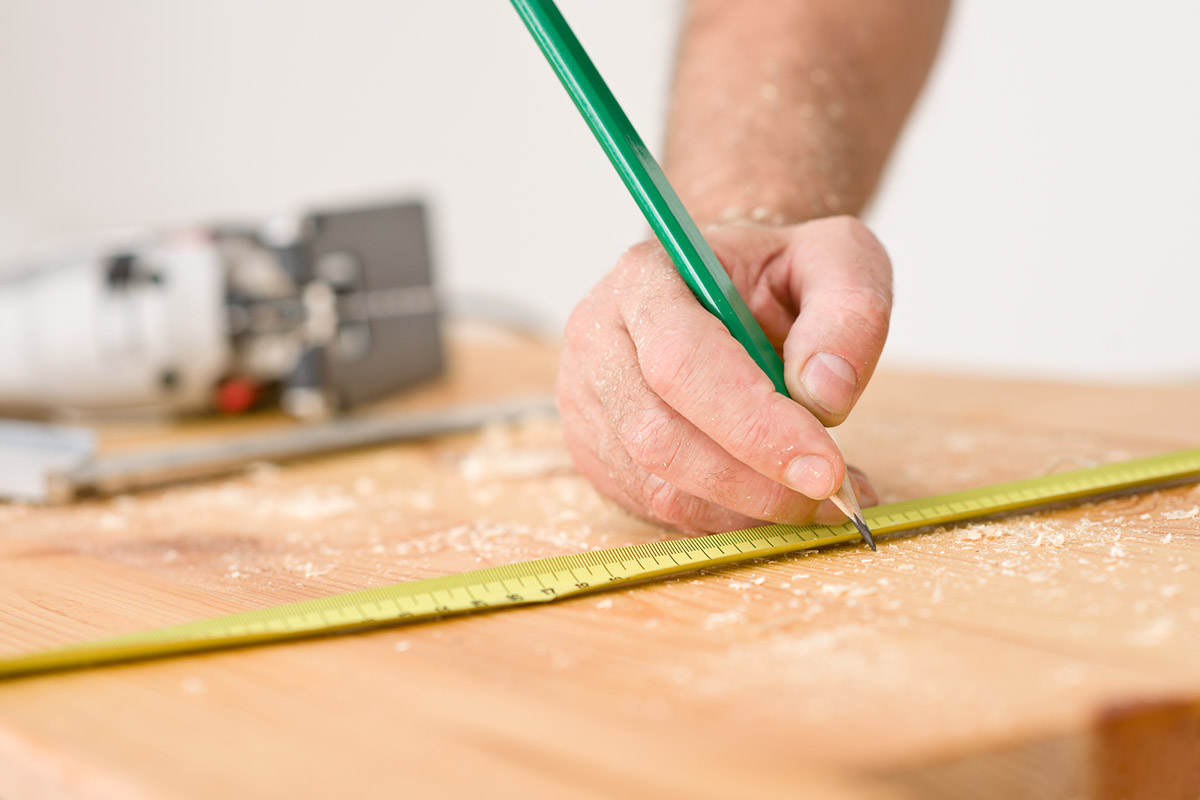
STEP 1: Cut your piece of lumber.
Once you’ve selected your 4×4 piece of untreated pine or cedar, cut it down to a manageable size. Measure from one end of the block to the desired length between 5 and 8 inches. Make a cut mark, then use a circular saw or handsaw to cut the block. Any additional wood can be used to make extra traps.
STEP 2: Use a drill to create a base hole.
Next, create the first tunnel for the carpenter bees. On one of the cut ends of the wood, measure and mark the midpoint. Using a power drill with a ½-inch drill bit, drill all the way through. A visible hole should run all the way through the length of the wood.
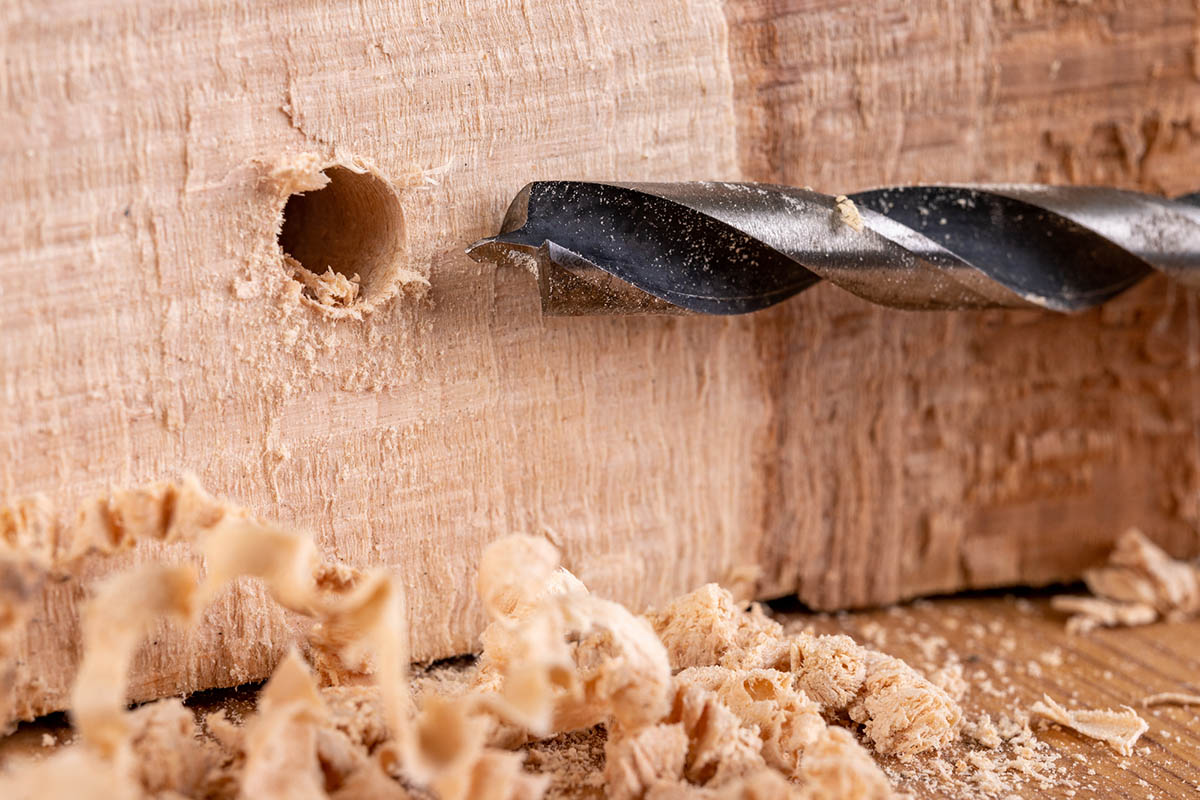
STEP 3: Drill three side holes at 45-degree angles.
Once the center hole has been made, connecting side holes are needed to add multiple entry points for the carpenter bees. Choose three long sides of the block to drill holes. Using the same ½-inch drill bit, drill three separate holes at 45-degree angles that drive up toward the center hole and end there. This creates a connected tunnel system. Be sure to drill these side holes going at an upward angle so that sunlight cannot shine down into the trap.
STEP 4: Create the “roof” of the trap.
The 6-inch-wide plank of wood will become the roof of the carpenter bee trap. Measure and cut the length you need, ensuring that it’s long enough for 1 inch of overhang on each side. Position the roof on top of the block of wood, making sure the side holes are still angled upward, then nail it in place with a hammer.
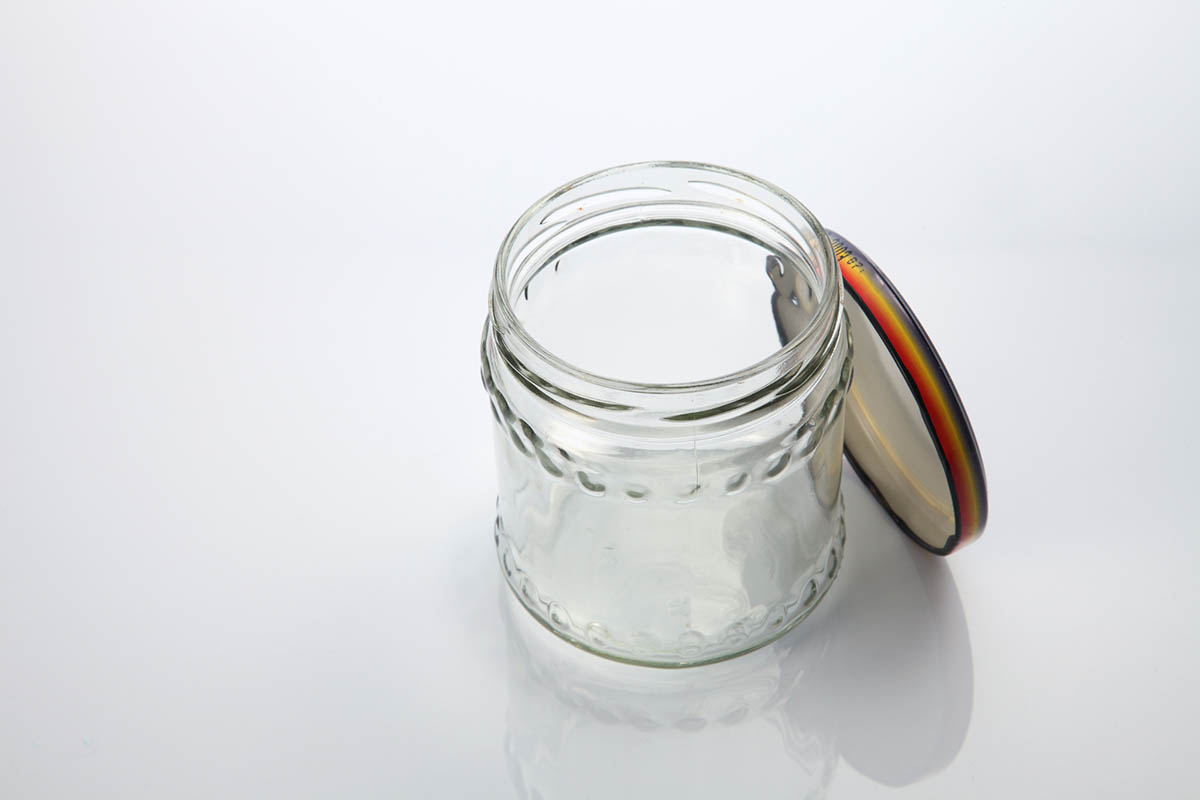
STEP 5: Take a mason jar lid and make a hole at the center of it.
Remove the lid of the mason jar and set it on a piece of scrap wood or right over the hole on the bottom of your block. Mark the center of the lid. With the ½-inch drill bit, drill a hole in the center of the lid. This lid will act as the transition point for the bees to travel from the block to the mason jar.
STEP 6: Attach the jar to the base.
Attach the mason jar lid to the base of the tunneled-out block by nailing it in place with a hammer. Ensure that the hole in the jar and the central hole of the block line up. Make sure that the lid is flush to the block to prevent any bees from slipping out. Once the lid is secure, screw the mason jar onto the lid. If you are adding honey or sugar water, do this before you screw on the jar.
STEP 7: Hang the trap.
Screw an eye hook into the roof of the bee trap. Measure to find the middle spot so the trap will hang straight. You may want to use a small drill bit to bore a pilot hole if you have a large hook. Once the eye hook is securely fastened into the roof, thread a small chain, wire, or cable through it and secure it to the roof or a post that’s closest to the infestation. The side without a hole should be against the house or post that you hang the trap from. This helps to stabilize the trap.
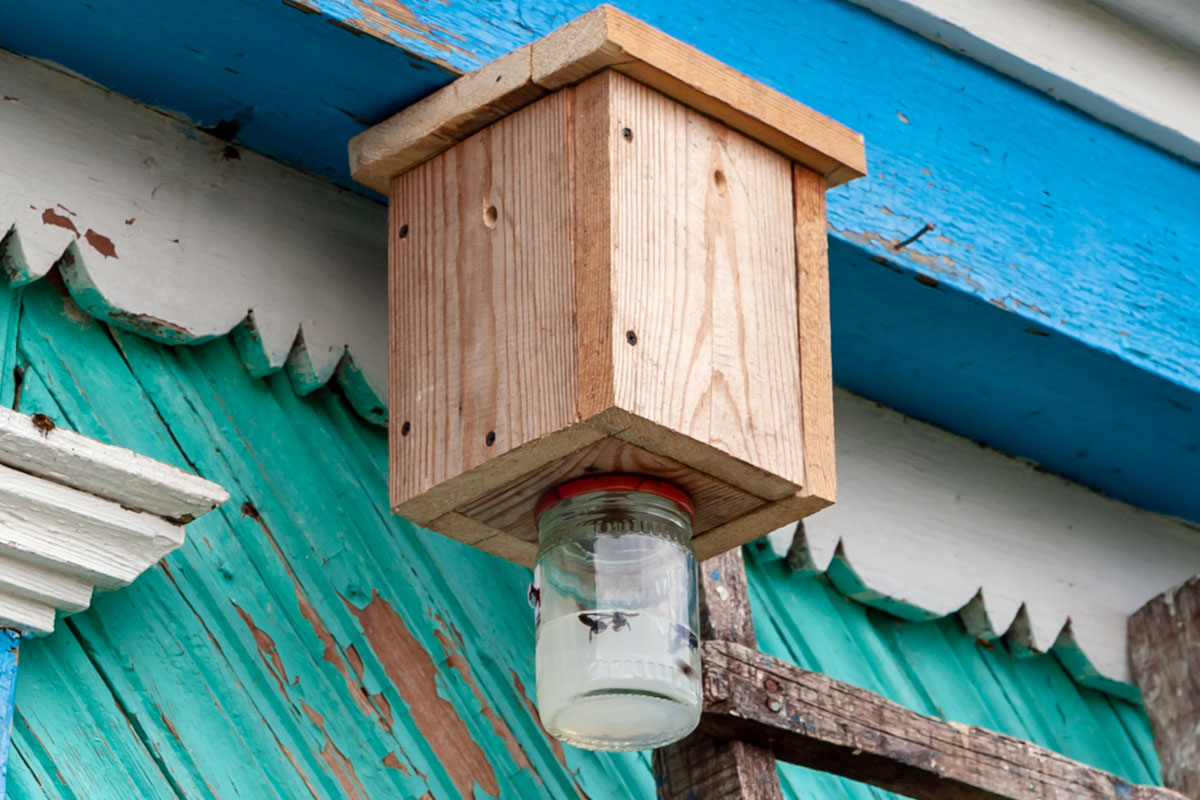
How Do Carpenter Bee Traps Work?
Carpenter bees prefer to burrow into soft woods where they can chew tunnels for the female bees to lay their eggs. If an existing hole is available, they often start there and dig deeper to suit their needs. The advantage of a carpenter bee trap is that it includes premade tunnel systems for them to naturally want to explore and utilize. Using a softer, untreated wood that carpenter bees would normally choose helps encourage them to investigate the trap.
Once the bees enter the side holes, they climb up and find the main channel as they explore the best place to lay their eggs. The clear mason jar at the bottom shines light up into the main hole of the block. Since the side holes are drilled at an upward angle, sunlight cannot shine down into them. Bees will think that the brighter light coming from the mason jar is their exit and make their way down toward the jar and end up trapped rather than outside as they expected.
If you’re a DIY enthusiast, these steps for how to make a carpenter bee trap will help you remove burrowing carpenter bees from your property. Carpenter bees are the likely culprit of the grinding sound near any untreated or unpainted wood surfaces. However, if you’re unsure of what pest is present, or you don’t feel comfortable handling a potential bee problem in your yard, a local beekeeper or pest management professional can always come to take a look. A professional can help to safely relocate these helpful creatures to another location.
